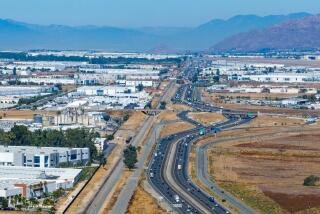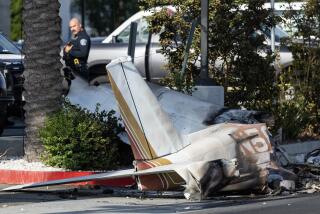Hawthorne Weighs Airport Expansion, Removal of Homes
- Share via
For the first time in nearly a decade, city officials are taking a hard look at Hawthorne Municipal Airport and a possible expansion that would provide more space for aircraft and businesses.
However, the expansion also would require the removal of as many as 173 homes north of the airport, according to a consultant’s report, and it already is encountering opposition.
A 12-member advisory committee is holding meetings to get public opinion on several alternatives, which were identified by a consultant hired to update the city’s 1979 airport master plan. The master plan provides guidelines for future use of the airport.
‘No-Build’ Option
The committee’s next meeting is tentatively scheduled for late May or early June.
While the Irvine-based firm, Foresite West, lists a “no-build” alternative in its report, it rejects this choice because it “makes it difficult to sustain the airport financially or meet increasing growth in demand.”
Proponents of expansion note that the airport has a long waiting list for aircraft parking and say it needs to modernize commercial services for airport users.
Improved facilities would attract new business to Hawthorne and increase city revenues through sales and business taxes, said Robert D. Trimborn, airport administrator.
Trimborn stressed that the city has made no decisions on the expansion. After more public meetings, the advisory committee--made up of residents, airport users and businesses--will present recommendations to the City Council and a formal public hearing will be held, possibly in July, he said.
Under the consultant’s $139,000 contract--10% paid by the city and 90% through federal funds for airport development--the firm will oversee the planning process and conduct an environmental study of development alternatives, Trimborn said.
In an inch-thick planning document, Foresite has outlined six alternatives, including four for expansion, one for no growth and one for airport closure, which is considered highly unlikely and also is not recommended by the consultant.
All four expansion plans would involve removing homes north of the airport, which is bounded by Prairie Avenue, 120th Street, Crenshaw Boulevard and Northrop Aircraft’s design and development facilities.
The most conservative of the four plans would require removal of 72 homes to make 11.6 additional acres available for airport development. The most drastic calls for removing 173 residences to provide 25.5 more acres.
The consultant identified as its “preferred alternative” a plan that would provide 20 more acres for airport use by removing 106 residences.
At a committee meeting last month, only a handful of homeowners showed up to protest the removal of housing, but they said area residents have not been properly alerted to the proposals. Trimborn said the meeting was announced in a newspaper but individual property owners were not notified.
“We have lived here since 1941,” said Fern Bush, whose home is on 119th Place a block from the airport. She is in her 70s and her 84-year-old husband, James, is a retired aircraft employee who worked at the airport.
Proposed Rezoning
“It would be quite an upset to have to move,” she said in telephone interview. “We planned to stay here till we die.”
If homes are to be removed, officials said, the city would have to purchase the property through condemnation and relocate residents. That is not much consolation to Leola Condie, who lives next door to the Bushes.
“When you are my age--81--it would be a hardship no matter whether they give you another house or how well they relocate you,” she said.
The modest residential neighborhood north of the airport has had more than its share of relocation scares. Homes there narrowly escaped being condemned for the Century Freeway.
In recent months, Hawthorne planners have suggested making the area a redevelopment district and rezoning it from residential to freeway commercial, which also could lead to condemnations. Now there is the prospect of removing homes for the airport.
Proponents argue that improvements are needed at the 46-year-old airport. Except for the airport headquarters, built in 1966, and a facility built in 1985 to provide flight-plan services and weather briefings for pilots, little has been done to modernize the airport since 1952, Trimborn said. Some dilapidated commercial structures date back to facility’s opening on June 19, 1942, he said.
Northrop Aircraft, a division of Northrop Corp., acquired the property in 1939 with the understanding that the City of Hawthorne would operate it as an airport.
The airport was operated by Northrop until 1948, when the city took control. Northrop continued to provide control tower service until 1961, when the Federal Aviation Administration took over.
As part of a complex agreement, Northrop was granted exclusive use of about 14 acres on the south side of the airport, adjacent to its extensive aircraft design and development facilities on Northrop Avenue.
Control of Runway
Northrop does not use the airport for test flying but to serve arriving and departing executives and staff, Trimborn said. Were the city to close the airport, Northrop would retain control of the runway, Trimborn said.
A Northrop spokesman said the company is aware of the city planning process but has no comment at this time.
The airport is self-supporting, with its $500,000-a-year budget paid from user fees and other airport revenues, including federal funds, Trimborn said.
For eligible airport improvement projects such as installing lighting or repaving the runway, the federal government foots 90% of the bill and the city pays only 10%, he said.
Flight activity has declined from a peak of 284,611 landings and takeoffs in 1968 to 130,714 in 1986, but the consultant predicts there will be 224,100 flight operations at Hawthorne by the year 2006.
Spiraling Costs
The decline in flights reflects a nationwide trend in which spiraling costs have discouraged flights by small planes, especially for recreation and training, Trimborn said.
Trimborn said that some officials believe that as land transportation becomes increasingly congested, the demand will increase again, principally for corporate and business flights. Hawthorne hopes to attract these flights by improving its facilities, he said.
The proposed expansion also would capitalize on a pent-up demand for storage places for small aircraft, Trimborn said. The airport has a waiting list of 55 applicants for tie-down parking spaces and 141 for hangars, according to the consultant’s report. It did not specify how many spaces would be provided by the various options.
Pilots also seem to favor modernization. They and Federal Aviation Administration officials note that Hawthorne is an important link in the chain of airports that make up Southern California’s air transportation system. Hawthorne is classified as a “reliever” airport, which services smaller planes to lighten the demand at major airports.
Hawthorne airport needs improvements, said Mitchell West, a director of the Hawthorne Aircraft Owners and Pilots Assn.
“Hawthorne airport currently is the least viable airport regarding services on the field, activity levels and attractions to pilots in all of Southern California,” he said. The airport should have more maintenance and fueling facilities, he said.
“What I have observed in five years of flying out of Hawthorne Airport is that city policies and their ways of handling leaseholds are so highly constrained that they have effectively put out of business every operator on the field,” West said.
Trimborn acknowledged that city policies have resulted in some dissatisfaction among business operators who lease space at the airport.
“There have been some trying times for operators here, especially those that were not performing well,” he said.
The city decided, because of space limitations, to reduce the number of “fixed-base operators,” who provide full maintenance services for aircraft. With more large corporate planes using the airport, maintenance facilities need wider ramps and take up more space, he said. The airport can accommodate only two, rather than the original five, fixed-base operators, he said.
Overestimated Figures
Franklin S. Martin, a Westchester resident who owns a part interest in a plane at the airport, claims that city officials have overestimated flight figures and the parking shortage to continue receiving federal funds and to justify keeping the airport open.
In an interview, Martin contended that, in effect, Hawthorne is discouraging public use, and he said services for the general flying public are dwindling.
Trimborn denied Martin’s accusations, saying that the Federal Aviation Administration has confirmed its flight counts and that the city plans to improve services.
If the airport expands, some residents are fearful that flight activity and noise would increase.
David Kalian, a radar systems engineer who lives under the takeoff flight path west of the airport but not in the area targeted for removal of homes, questioned statistics presented by the consultant. He claimed the report downplays the increased flight activity that could result if the airport expands.
More Noise, Lower Values
“What do we get for sacrificing 106 homes . . . besides more noise and lower property values?” he asked.
Trimborn said the City of Hawthorne does not intend to lengthen the airport’s 1-mile runway to accommodate larger planes. The airport cannot expand east or west because of Prairie Avenue and Crenshaw Boulevard, he said.
The largest planes that normally use the airport are 12- to 18-seaters, he said. As for its safety record, Hawthorne has had only one fatal accident in the past five years, he said.
Noisy planes are not allowed to use the airport, and this has contributed to a fairly good rapport with airport neighbors, Trimborn said. Hawthorne has had so few complaints that the city has not found it necessary to impose a noise ordinance or monitoring system, he said.
“The last thing we want to do is build an airport that would be incompatible with the community.” Trimborn said. “We want to be a positive part of this city.”
More to Read
Sign up for Essential California
The most important California stories and recommendations in your inbox every morning.
You may occasionally receive promotional content from the Los Angeles Times.













